Slate Creek Divide Area
Fast Flight Facts
Target Species: Black-chinned Sparrow, Gray Vireo, Scott's Oriole and other chaparral/juniper species; Dusky-capped Flycatcher, Mexican Jay and other Pine/Fir/Oak/Sycamore species in Transition Zones
Elevation: 4000' through 6200'
Habitat: Chaparral and juniper covered slopes in lower elevations, drainages with ponderosa pine, Douglas fir, sycamores and oaks in Transition Zones
Overall Birding Rating: 5 (Top 10 Maricopa County Hotspot)
Difficulty: 3-5 (Moderate to Very Difficult)
Birding Type: Moderate to Difficult Hiking, Bushwhacking
Facilities: None; Convenient pull offs for camping overnight
Fees/Ownership: No fees, part of the Tonto National Forest
Closest Town or City/How far from Phoenix: Sunflower is the closest town, Slate Creek is 50 miles northeast of Phoenix
Getting there: Accessed from Highway 87 by a hard-packed dirt road that leads to high elevation forests
Overview: Despite suffering from two major wildfires: the Willow Fire in 2004 and the Sunflower Fire in 2012, the Slate Creek Divide Area in the northeastern part of Maricopa County is one of the best birding places in the county, where the unexpected may show up. Adjacently accessed from Mount Ord up through Forest Road 201, the Slate Creek Divide area offers great high elevation forests as well, but with a different mix of habitat. Douglas fir is dominant here, and is joined by ponderosa pine and oak. In some of the area's dense drainages, these conifers and oaks are also joined by extensive sycamore trees. This combination creates a habitat wonderfully similar to the canyons and mountain ranges in southeastern Arizona. Just like Mount Ord, the Slate Creek Divide Area is intercepted with the Maricopa and Gila County lines, crossing over each other many times. The best birding Slate Creek has to offer in the Maricopa County side come from a few drainages that run south, which require very careful hiking in hazardous areas that should not be explored alone.
Slate Creek Divide is known for having local rarities in the higher elevation conifer forests. These rarities have included Spotted Owl, Flammulated Owl, Northern Saw-wet Owl, Mexican Jay, Dusky-capped Flycatcher, and Red-faced Warbler. A remarkable Elegant Trogon was even found here once (T. Corman). Some of these species have declined in the area after a devastating fire, but may be around. Spotted Owl, Flammulated Owl, and Northern Saw-whet Owl have been detected again, and are once again confirmed in the area in recent times. Mexican Jays highly favor Slate Creek Divide, and are harder to find in the county's transition zones elsewhere. In one of the Maricopa County drainages with good sycamore/conifer habitat, breeding Dusky-capped Flycatchers were found in 2010 and have been present since. It was the first time this southeastern Arizona flycatcher was found breeding in Maricopa County. Historically, Red-faced Warblers once nested at Slate Creek Divide, but declined in the area and haven't been confirmed as nesting in the county again after the 2004 Willow Fire. There is still good habitat for the Red-faced Warbler in a few places if it ever decides to return again as a breeder. Thus, the Red-faced Warbler may be found in the area as a migrant for a lucky birder. The mix of sycamore, oak, Douglas fir, and ponderosa pine in the Maricopa County drainages offer great potential to attract higher elevation rarities on a Maricopa County scale and should be explored thoroughly. Look on the "maps" section of this page to get an overview of where to hike in these special drainages.
Quite similar overall in ways to the bird life of Mount Ord, similar species may be observed in both the lower slopes as well as the forests. Starting at and continuing up Forest Road 201 and passing through the lower slopes before reaching the higher elevations, both Gray Vireos and Black-chinned Sparrows may be observed, as well as Scott's Orioles, Canyon Towhees, and Rufous-crowned Sparrows. By spending several minutes listening and observing, these species will usually be located rather easily.
Once in the higher forest habitats, look and listen for breeders in Zone-tailed and Cooper's Hawks, Northern Pygmy-Owl, Anna's and Broad-tailed Hummingbirds, Acorn and Hairy Woodpeckers, Northern "Red-shafted" Flicker, Western Wood-Pewee, Dusky-capped and Ash-throated Flycatchers, Plumbeous and Hutton's Vireos, Western Scrub-Jay, Bushtit, Bridled Titmouse, Red and White-breasted Nuthatches, Brown Creeper, Bewick's and House Wrens, Blue-gray Gnatcatcher, Hermit Thrush, Olive, Virginia's, Black-throated Gray, and Grace's Warblers; Painted Redstart, Spotted Towhee, Hepatic and Western Tanagers, Black-headed Grosbeak, and Red Crossbill (sometimes).
Birds to expect during migration and at times throughout the year include Rufous Hummingbird, Olive-sided, Hammond's, Gray, Dusky, and Cordilleran Flycatchers; Warbling Vireo, Steller's and Mexican Jays, sometimes Pygmy Nuthatch, Ruby-crowned Kinglet, Western Bluebird, Orange-crowned, Yellow-rumped, Townsend's, Hermit, Red-faced (with some luck!) and Wilson's Warblers; Green-tailed Towhee, Lazuli and Indigo Buntings, and Pine Siskin.
Birding Tip: First and foremost importantly, do not ever come and explore this area alone. Exploring Slate Creek's best birding spots involves hiking in hazardous drainages where a combination of hiking down steep slopes with loose rocks the entire way, rattlesnakes, bears, mountain lions, and limited cell phone signal is the perfect reason why exploring in groups is important. To have good birding success in Maricopa County at Slate Creek Divide, go and explore the areas I have given visual directions to under the section "Pages" on this page, under maps. Directions are provided with tips on routes and finding a few of the rare in Maricopa County birds, such as the Dusky-capped Flycatcher.
Directions: The access point of Slate Creek Divide is reached along the Highway 87 (Beeline Highway) just north of milepoint 222, by taking the turnoff to Sycamore Creek to the west (adjacent to the Mount Ord turnoff to the east). This turnoff is about 35 miles north of where Shea Blvd. meets the Highway 87, as Shea Blvd. is a popular access point when taking the Beeline Highway anytime. Once turning on the Sycamore Creek turnoff, this is actually part of the Old Beeline Highway. After driving west for 1.2 miles on the Old Beeline Highway, you will come across a dirt road turnoff that goes in the northeast direction, which is Forest Road 201. Take this road to the higher elevation forests, which is close to ten miles in length. Forest Road 201 is in decent condition, and is drivable for most vehicles. It only has a few rough patches throughout the road's duration. For visual directions, see the Slate Creek Divide Area Maps on this page under the "Pages" section.
Pages:
Slate Creek Divide Area Maps
Take Me There (Google Map)
Slate Creek Divide eBird Data
Scenes and Sights from the Slate Creek Divide Area:
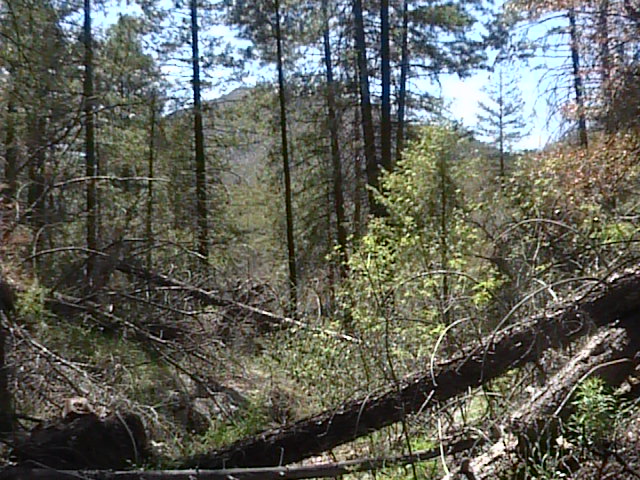

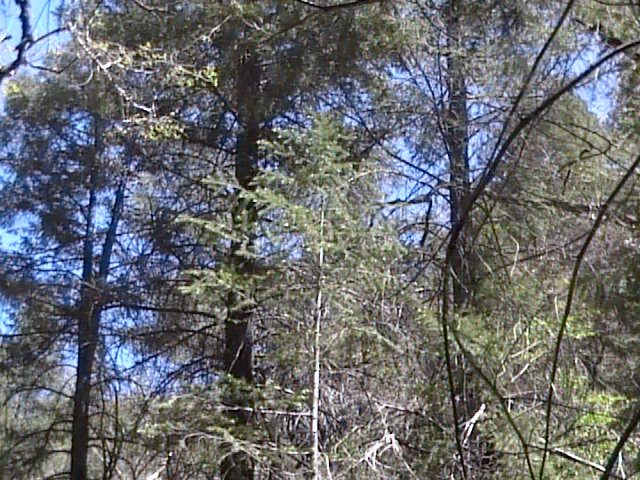
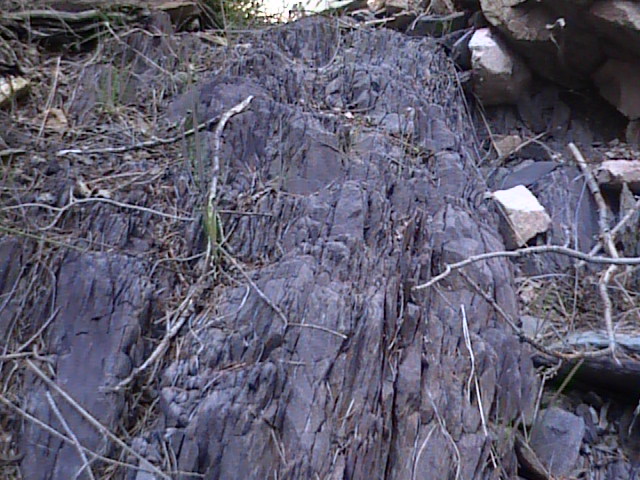
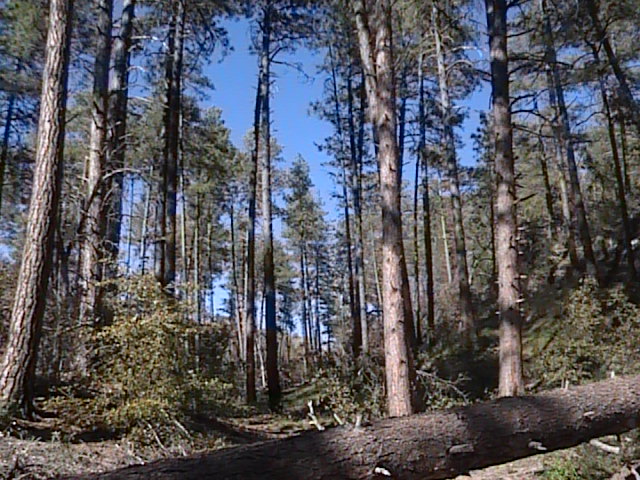
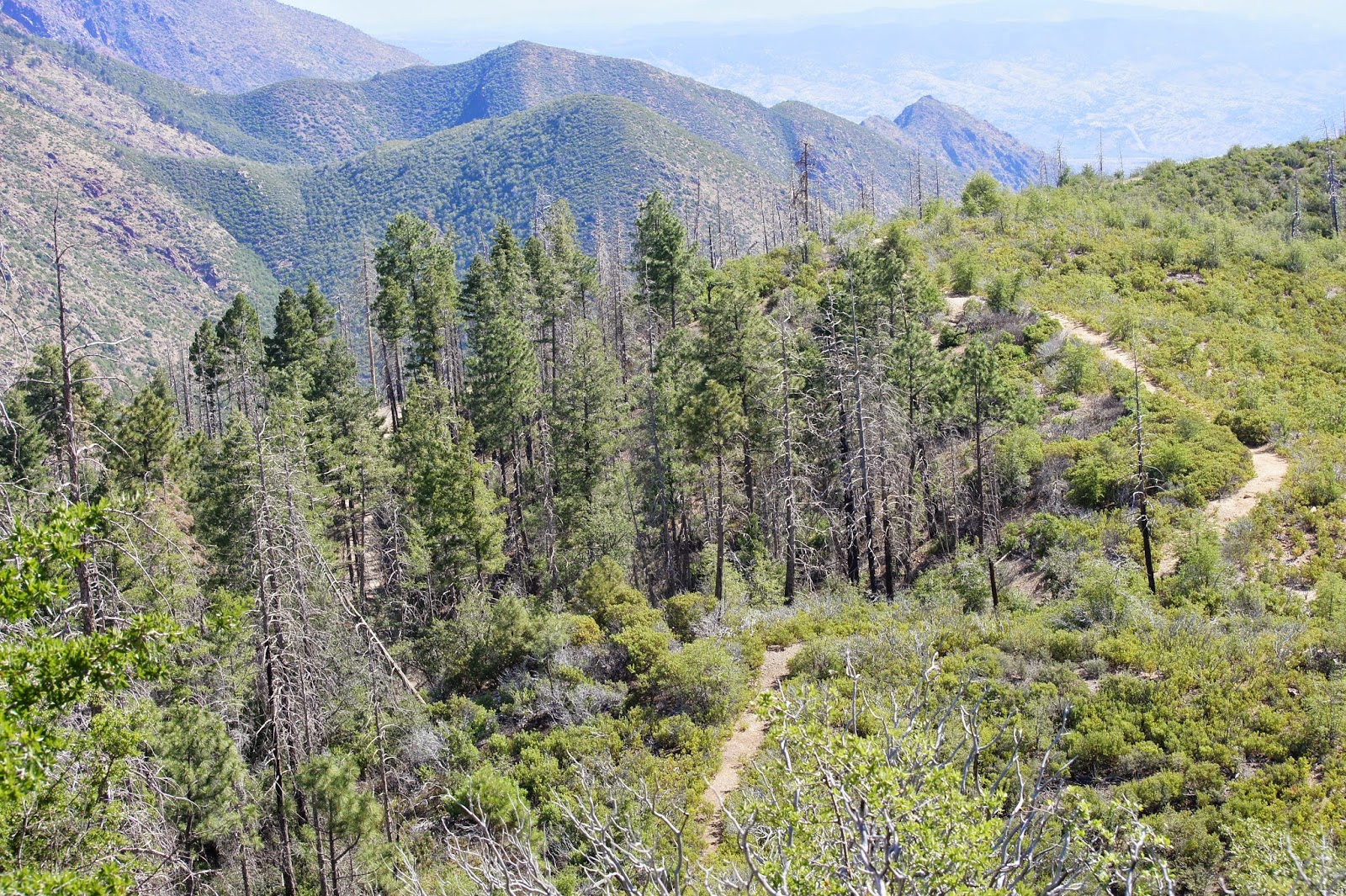
The sad result of human caused fires

Lower slopes of the Slate Creek Divide Area

Birdlife of the Slate Creek Divide Area:
Common Poorwill
Dusky-capped Flycatcher-rare in Maricopa County (Slate Creek Divide holds a local breeding population)
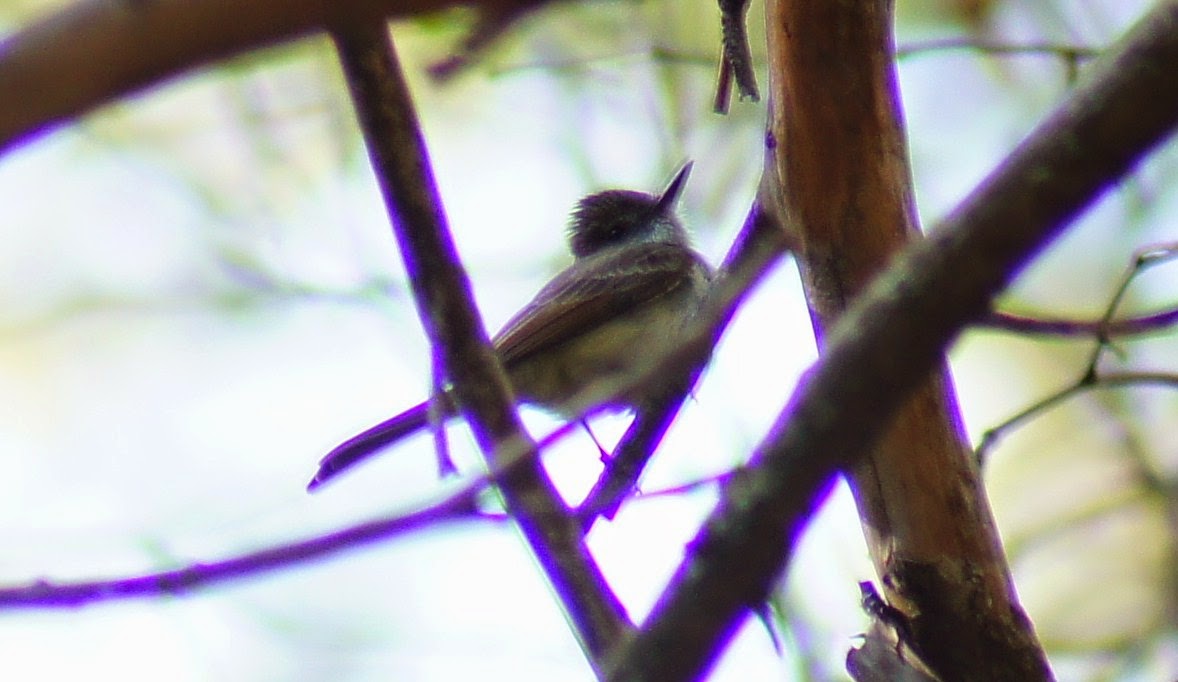
Mexican Jay-rare in Maricopa County (Slate Creek holds a local breeding population)
Mexican Spotted Owl-very rare and local in Maricopa County. It is also a federally threatened species. Do not use playback at night to call this bird in. If it's found during the day, don't use flash photography, don't get too close to it, and don't linger in it's area for too long.

Western Wood-Pewee

Painted Redstart
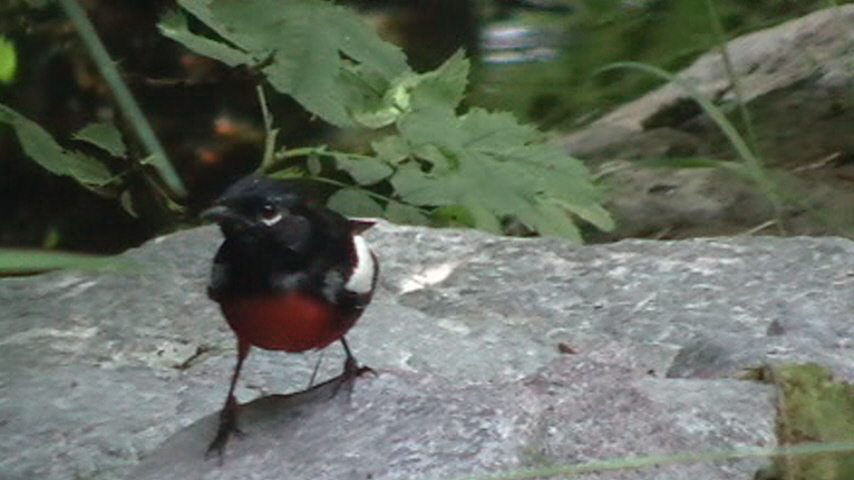
Brown Creeper
Red-faced Warbler (Poor but diagnostic photo) Formerly a breeder, now just known as a scarce migrant in the county

Bridled Titmouse
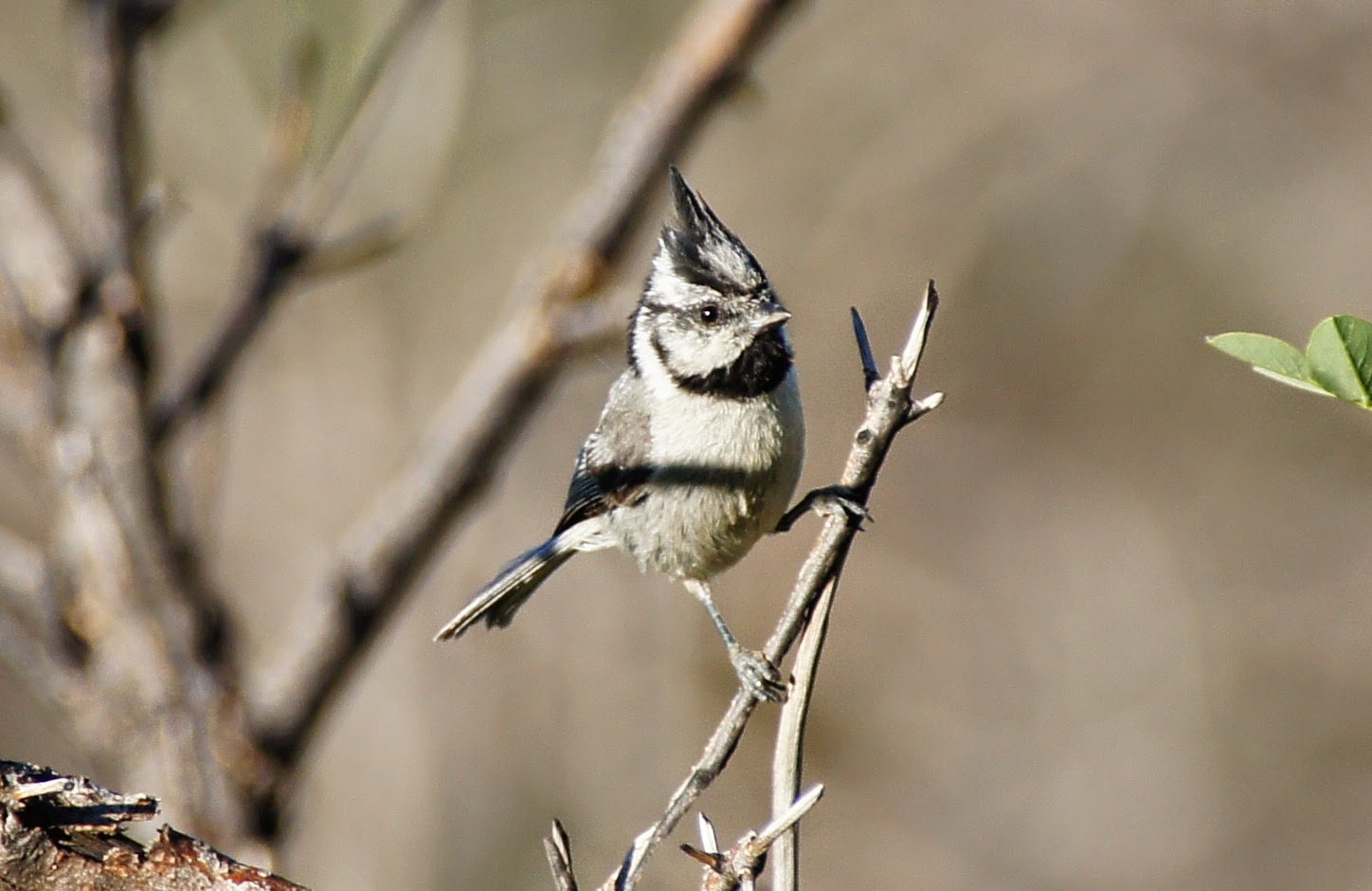
Broad-tailed Hummingbird
Bushtit

Back to Area 1-Highway 87 from Desert to the High Country |
